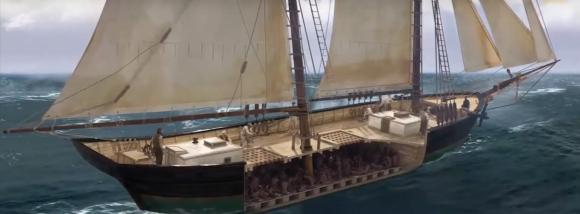 In January 2018, the news broke that a journalist believed that he had found the burned wreckage of the schooner Clotilda, the last vessel to carry Africans into bondage in the United States. By March, however, further research and excavation determined that the wreck was, in fact, not that of the infamous slave ship. Nevertheless, the near-discovery triggered renewed interest in finding the wreck.
In January 2018, the news broke that a journalist believed that he had found the burned wreckage of the schooner Clotilda, the last vessel to carry Africans into bondage in the United States. By March, however, further research and excavation determined that the wreck was, in fact, not that of the infamous slave ship. Nevertheless, the near-discovery triggered renewed interest in finding the wreck.
Last week, the National Geographic Society reported that the Clotilda has been found, discovered by archaeology firm company Search Inc, which was called in to help by the Alabama Historical Commission to investigate a likely wreck off Twelve Mile Island in the Mobile River delta. The dimensions and construction of the wreck matched those of the Clotilda, as did building materials, the commission said.
“We are cautious about placing names on shipwrecks that no longer bear a name or something like a bell with the ship’s name on it,” maritime archaeologist James Delgado said in a statement. “But the physical and forensic evidence powerfully suggests that this is Clotilda.”
As we wrote previously, the international slave trade had been illegal in the United States since 1807, but that didn’t entirely stop the evil business. Local lore suggests that the voyage of the Clotilda began as a wager between Timothy Meaher, a wealthy Alabama ship and shipyard owner, and friends from New England. Meaher wagered that he could smuggle slaves from Africa into the United States without being caught.
In the autumn of 1859, or the summer of 1860, depending on the source, Captain William Foster brought the schooner Clotilda into Mobile Bay with a cargo of 110-160 captives from West Africa. Federal authorities had been tipped off to the arrival of the schooner. Fearful of criminal charges, Captain Foster arrived in the port at night and transferred his cargo to a riverboat, then burned and scuttled the Clotilda.
“The discovery of the Clotilda is an extraordinary archaeological find,” said Lisa Demetropoulos Jones, the executive director of the Alabama Historical Commission. “The voyage represented one of the darkest eras of modern history and is a profound discovery of the tangible evidence of slavery.”
USA Today notes that the enslaved people on board remained captive until the end of the Civil War. A small group of survivors and descendants then reunited in hopes of returning to Africa but instead created a new community – known today as Africatown – in the Plateau area of Mobile.
“This new discovery brings the tragedy of slavery into focus while witnessing the triumph and resilience of the human spirit in overcoming the horrific crime that led to the establishment of Africatown,” Jones said.
How discovery of the slave ship Clotilda informs U.S. history

Yes slavery was such an evil in all its forms and still is as it still goes on today, it is worth remembering however that without Thomas Clarkson the Britton, Wilberforce would never have got his bill through the British Parliament. How many know that the British anti slavery patrol took its last slave ship in 1987 when Fogarty Fegan the grandfather of his famous descendant awarded the Victoria Cross for his valiant fight in WWII in HMS Jervis Bay, that slaver was a Dhow off Zanzibar Island, Captain Fegan of HMS Turquoise had told the Sultan of Zanzibar he would fire his city if he did not stop slaving. It is worth remembering that without the African and the Arab the Europeans could not have operated the slave trade, a trade that the Drake and Hawkins found already going on in Africa in 1572, they and others only turned it into a successful industrial enterprise. I sailed in the Freedom Schooner Amistad remembering not particularly slavery but, slavery from the perspective of the American diaspora when I joined the schooner out of Senegal in 2008 for her Atlantic crossing. Captain Bill Pinkney of African decent used to say that there are more people in unpaid servitude than there were ever in the days we regard as slavery, he said that in 2008. Clotilda would have been typical of the Baltimore clipper style of schooner at around 80 feet just the type of vessel used in the latter day slave trade Amistad replica is of a similar length but in her case she was an inter Island transport and NOT a slave ship in her case the Amistad incident for which there is the film by Spielberg of the name morphed into the Amistad incident it can be found on the USA government web site as Americas in 1840 first human rights case and well worth a read in her case the actual slaver was Portuguese and named Tecora. I have yet to find an African who will admit they were accomplices in the trade.
Good article, Rick. This is an important find, historically. It demonstrates the value of smuggled human cargo that the captain would burn and scuttle the ship after delivery.
Its beginning to be reported in the UK
See – https://www.bbc.co.uk/news/world-us-canada-48377930
It seems that should she be raised/restored many are determined that it will stay in the local area.
As ever some sense money is to be made in various ways.